Pizzica – it sounds like a kind of pizza, doesn’t it?
Well, Pizzica is nothing you would want to eat. It’s Southern Italy’s dance phenomenon. If you have ever danced the traditional Italian wedding dance known as the Tarantella in the Italian American community, then you will immediately recognize the music and the steps of the Pizzica dance sensation so popular in Italy.
A few years ago, when Bob and I were studying Italian in Ostuni just an hour south of Bari, our teacher, Stani, filled us in on the Pizzica dance movement and its connection to the Tarantella.
I’ve always loved dancing the Tarantella at family weddings, at the huge receptions where everyone in the family, from toddlers to grandparents, aunts and uncles, and all the cousins dance the Tarantella in a big circle on the reception floor. As a little girl of six or so, I remember running out onto the floor with my sister Anna and dancing my heart out. I can still remember my Grandma Carmela dancing the Tarantella with my cousin Joey when he was a teenager – tapping their feet and twirling with the Tarantella tambourine. Ta dà ta dà ta dà ta dà…! Even now when that music gets in my head, I have to move my feet!
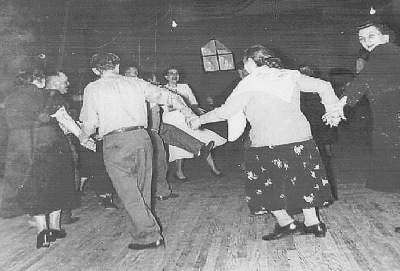
From left to right: Martino brothers and/or their wives: Uncle Pete, Aunt Mary, Uncle Joe, Aunt Beatrice, and Aunt Emma dancing the Tarantella!
And who could forget Joe Fusco and his band who seemed to play at all of our family weddings? Joe’s band played the Tarantella at our wedding reception nearly 40 years ago. In keeping with tradition, Bob and I danced the Tarantella with our family and friends much like our relatives had decades before us.
So, when I heard how similar the music of Pizzica is to Tarantella music, I had to find out more.
Here is what I discovered about the Tarantella – Pizzica dance and music connection.
For thousands of years, the inhabitants of Italy’s heel-shaped peninsula have been sharing their rich land with the tarantula. The fear – then as now – was getting bitten by this very big spider, and waiting for the poisonous venom to slowly make its way into the bloodstream and the brain.
I checked out the poisonous effects of tarantula venom on the human body, and it’s not as dangerous as you might think! Tarantula poison won’t kill you unless you are allergic to it. BUT, out of 900 different types of tarantulas, there are only a few whose venom could cause intense muscle spasms, convulsions, and pain for several days. Whew – only that!
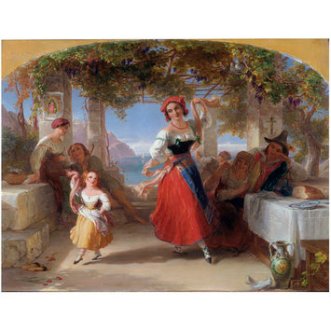
“An Italian Mother Teaching her Child the Tarantella,” by English portrait artist Thomas Uwins in 1842.
Many centuries ago, the contadini (farmers) of Southern Italy were superstitious like most Medieval peoples in Europe, and the bite of a tarantula was a feared affliction. People believed that the venom was a demon that could take possession of a victim’s soul. So sometime in the 11th Century, maybe earlier, they created a ritual for exorcising the tarantula venom from the victim’s body and for healing the spasms, convulsions, and pain of the spider’s bite.
This ancient ritual took the form of a foot tapping, fast-paced, ecstatic dance.
Healers beat tambourines to drive the poison out the victims’ bodies as the victims stomped their feet and twirled in circles. They would dance for days if they had to. Sometimes they even went into trance-like states, gyrating and twisting and pounding the ground with their feet to drive the demon poison out of their bodies, before finally collapsing in exhaustion, hoping to be cured by this dance of spiders they called the Tarantella.
Gradually the Tarantella dance became popular as a remedy for depression and emotional problems. Around the turn of the 20th Century, many women in Italy’s poverty-stricken south were suffering from feelings of hopelessness at their never-ending struggle to feed and clothe and care for their families. They turned to the fast-paced, foot-tapping Tarantella dance as a kind of antidote to their troubles, a kind of release valve for their pent-up miseries. These women danced to exorcise the venom of unhappiness from their bodies, their minds, and their hearts. Folk dance as folk medicine.
The tradition of the Tarantella dance evolved again when it became a part of family celebrations and weddings. Our Italian immigrant ancestors brought the Tarantella with them when they crossed the Atlantic and found their way to the rich farmland of California. So traditional is this dance in Italian American culture that film director Francis Ford Coppola featured it in his first Godfather movie!
Meanwhile, back in Southern Italy, sometime in the 1990s, the Tarantella dance tradition was changing yet again, and making a big come back as the Pizzica movement. The steps have remained very similar to the ancient healing Tarantella and the wedding Tarantella of centuries gone by. The music today still uses tambourines, violins, and guitars, but now flutes, mandolins and accordions have been added to create sounds that mimic the fast movements of the tarantula and the spasms and convulsions caused by the spider’s bite.
The name of this dance, Pizzica, comes from the Italian verb pizzicare which means to bite or pinch or sting, a clear reference to the bite of the Tarantula spider.
Every region in Southern Italy has developed its own version of Pizzica music, dance routines, and costumes which often involve full black skirts and passion-red scarves. In addition to Puglia, the regions of Campania, Basilicata, Calabria, and Sicily have adopted the Pizzica movement and made it a part of their identity.
The region of Salento at the bottom of the heel of Puglia seems to be at the forefront of the Pizzica movement. The most famous musicians and dancers come from this region. And every August, throughout the province of Lecce, just south of Bari, there is a month or more of Pizzica music and dance events in a festival called La Notte della Taranta (The Night of the Tarantula). People come from all over Italy to participate in these popular summer spectacoli (events) in the region.
Here in our adopted home of Ascoli Piceno, we’ve found that the Pizzica movement is also very popular!
At a political rally for a city council candidate, a Pizzica group from Puglia played in a piazza under the stars, the music vibrating off of the Medieval stone buildings, the tapping of the dancers’ shoes ringing on the ancient cobblestones. At a local winery in the grape growing vineyards outside Ascoli, Pizzica dancers performed for the wine tasters. And a Pizzica dance troupe opened an art exhibition in the main piazza of our town.
Here is a video we took of dancers performing Pizzica at a dinner we attended with friends.
Ta dà ta dà ta dà ta dà…! Mi scusi – it’s that Pizzica music again – I have to go now – gotta dance! Until next time …
I hope you enjoy these links to more information about the Pizzica dance movement in Italy.
http://www.madeinsouthitalytoday.com/the-pizzicarella-dance.php

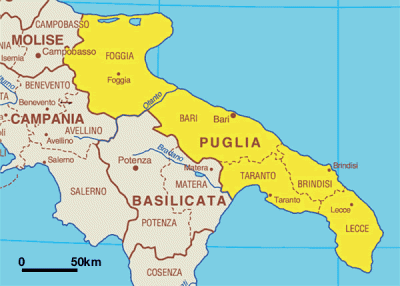
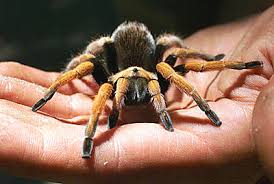
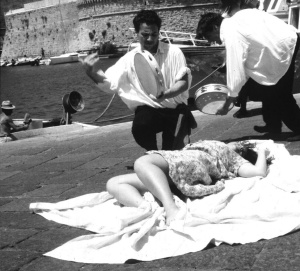
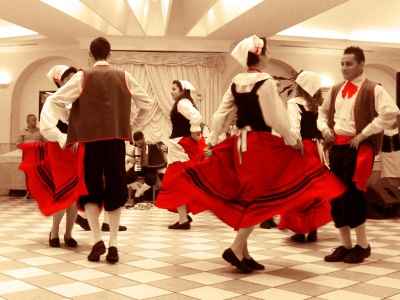
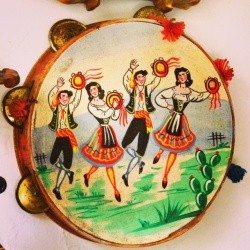
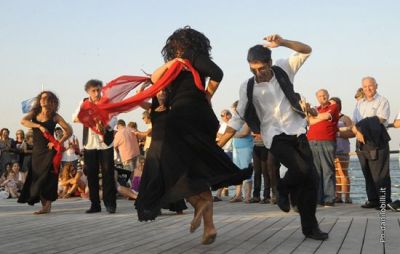
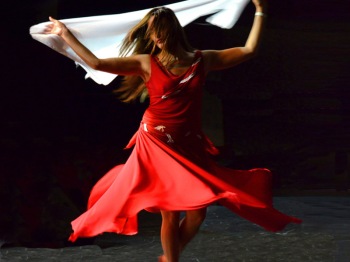
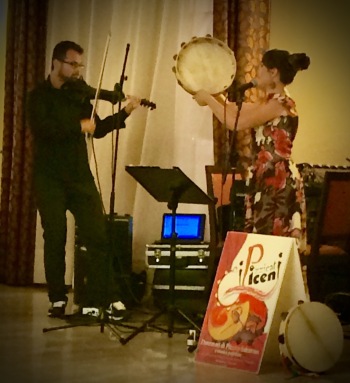
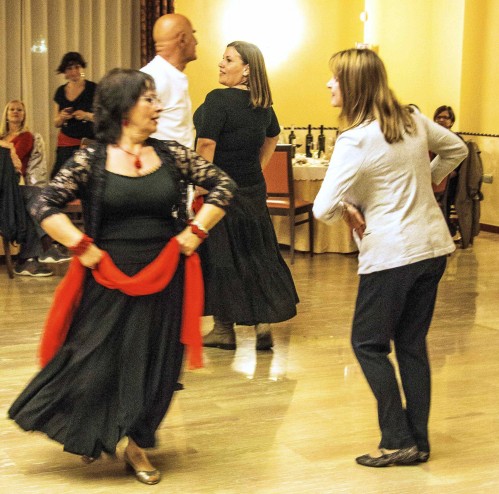
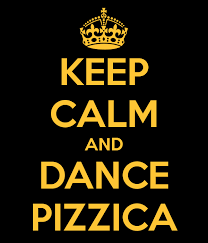
HI HONEY WHAT A GREAT E MAIL , I ENJOYED THAT SO MUCH MY SON HADS HEART PROBLEMS THE ELECTRICAL DELAY IN HES HEART IS WORSE AND A BAD HEART MUMMER IVE BEEN REALLY WORRIED WE ARE MOTHERS WE CANT HELP IT ;;;;;;;;;;;;;;;;;;;;;;;;;;;;;;;;;;;;;;;;;;;;;;;;;;;;;;;;;;;;;;;;;;;;;;;;;;;;;;;;;;;;;;;;;;;;;;;;;; ITS HOT HERE , IM SO GLAD YOU STILL ARE IN ITALY GOD BLESS YOU AND BOB AUNT JAN
Dear Aunt Jan, so glad you have been enjoying our posts! We have so much fun researching and writing them! We send prayers for your son and for you! Much love, Carmel and Bob
Thank you very much for mentioning my Association”Piceni Pizzicati” on this document.Very good the presentation of the history of pizzica throughout the centuries-I remember you and the evening when the photos were taken
Cara Rita, sono così contenta che hai letto il mio blog! Mi piacerebbe ballare con te la prossima volta che siamo ad Ascoli! Spero che il prossimo anno!!!
Grazie e ti mando tanti baci!
Thank you for mentioning us “I Piceni Pizzicati” on this document.Very good the hystorical presentation of the pizzica .I’d be very glad to meet you again to dance a magical pizzica here in Ascoli Piceno.